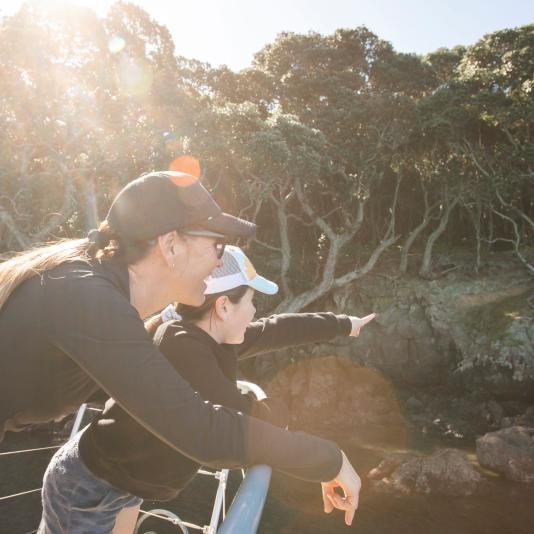

Discover Our Winter
see & do .
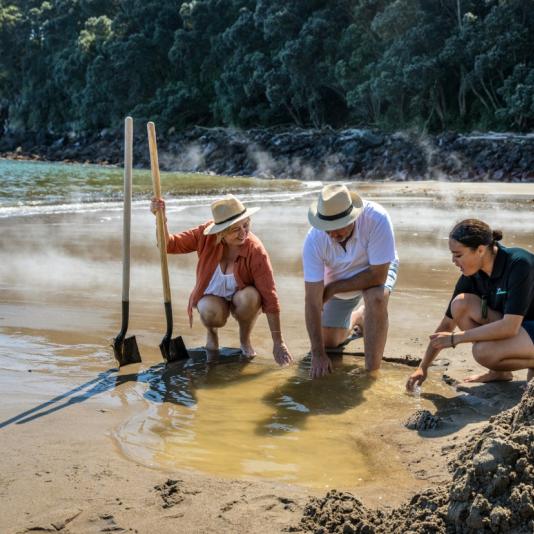
Moutohorā Eco Sanctuary
See all events.

Winter Events Guide

Feature Events
Plan your trip.
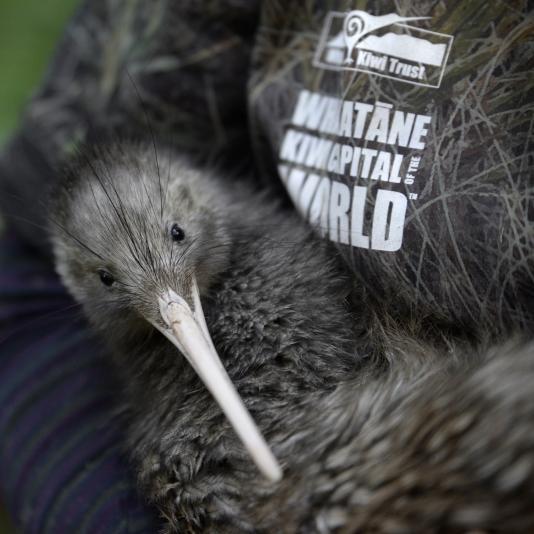
Kiwi Capital of the World ™
- Live A Work
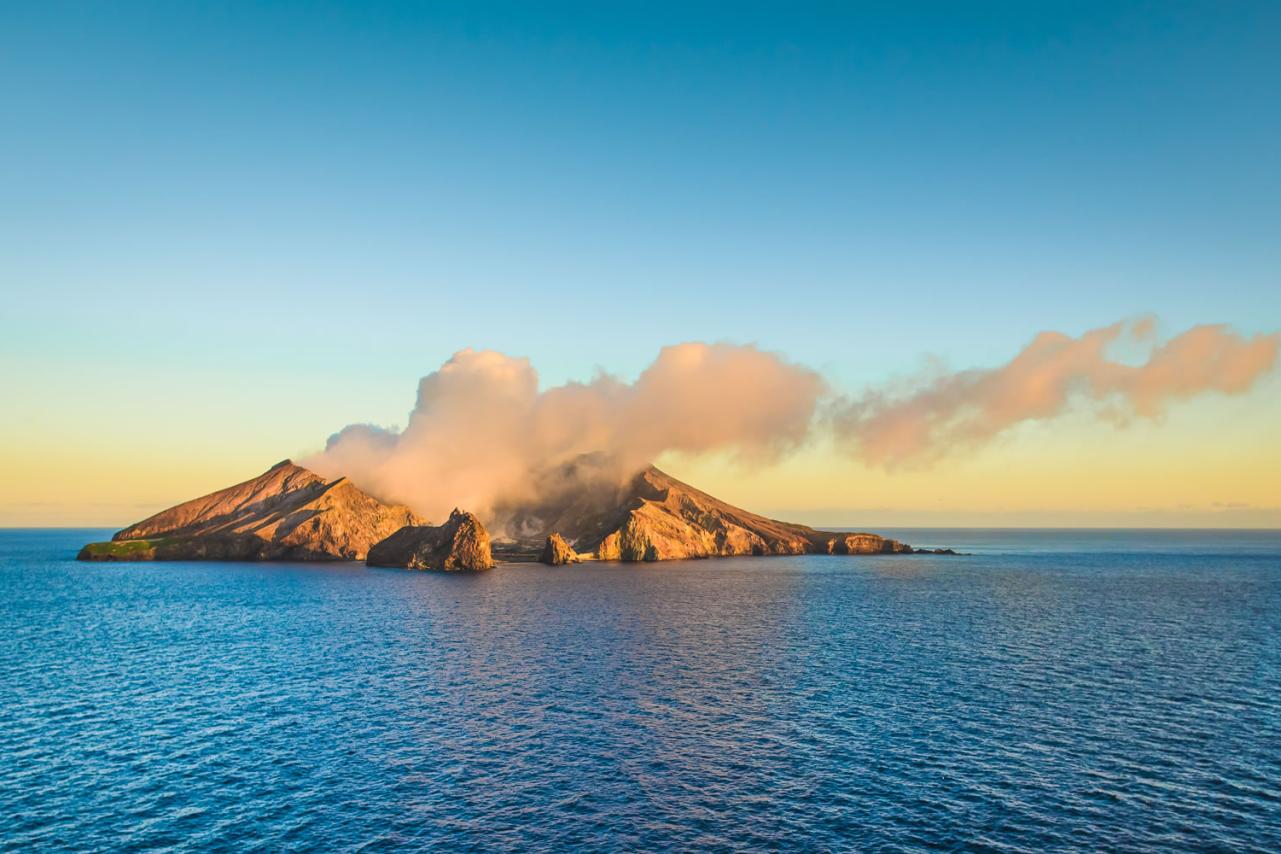
Whakaari/White Island
Whakaari/White Island is an active marine volcano that has attracted visitors from around the world for decades. To Māori and local Iwi (tribe) Ngāti Awa, Whakaari is a treasured ancestor and features in many stories and legends of the region. Glimpses from the shore and in the air offer breath-taking views of this geothermal wonder.
Estimated to be between 150,000 and 200,000 years old, the volcano is located 49 kilometres offshore from Whakatāne. It is two kilometres in diameter and its peak rises 321m above sea level.
The tragic eruption event that occurred at Whakaari / White Island on Monday, 9 December 2019 significantly impacted many people, both in Aotearoa and internationally. We acknowledge the families and loved ones of those who passed away, and send strength to the injured and their families during their recovery. As a result of the eruption event, there are currently no on-land tours of the island in operation.
You can still experience the unforgettable sights of Whakaari/White Islands, including scenic flights, on-land (not the island) lookout points and in the Whakaari/White Island Experience Room at the isite Visitor Information Centre.
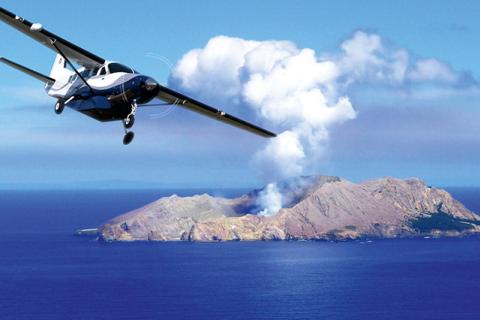
White Island Flights
For a truly unforgettable experience, join the White Island Flights team for one of their great value White Island scenic flights.
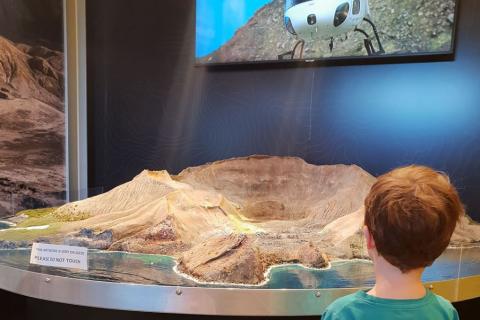
Whakaari Experience Room
The Whakaari/White Island Experience room provides a stunning up-close and informative experience of this geothermal wonder.
Remarkable visibility, underwater steam vents and an abundance of marine life make the waters around the island one of New Zealand’s best dive sites. It’s also a fishing haven, with charter boats offering multi-day game fishing adventures.
Lookout points
There are several lookout points in the Eastern Bay of Plenty that provide views across the ocean to Whakaari/White Island. On a clear day you can see steam clouds puffing from the crater at The Whakatāne Heads, Kōhī Point or any spot along the coastline.
If you have any questions about your visit to the Whakatāne District, please contact our isite Visitor Information Centre team .
Want to know more about Whakaari / White Island, visit the GeoNet website's frequently asked questions page .
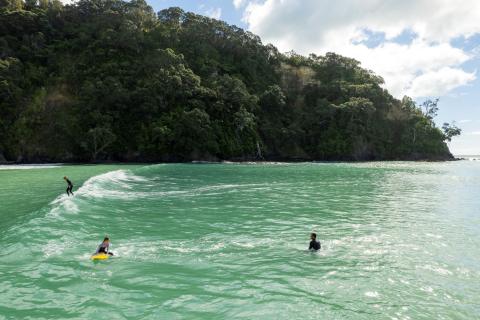
Autumn like this?
Visit us this autumn, settled weather and plenty of space to enjoy the great outdoors.
Helpful tips
Here's a few useful links to help with planning your trip to Aotearoa New Zealand.
- Best things to do in the North Island
- Best things to do in the South Island
- Other Islands
- Best ways to travel around
- Calculate travel times and distances
Whakaari/White Island
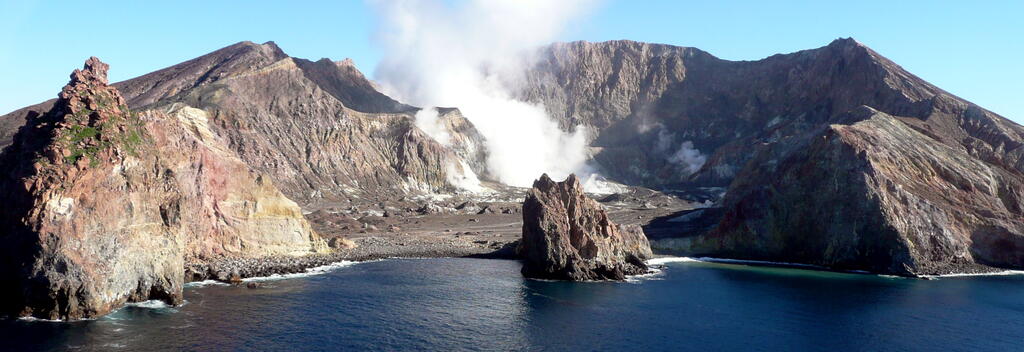
White Island, Bay of Plenty
By GrahamIX
Whakaari / White Island is one of New Zealand’s most active volcanos, situated 48km off the coast of Whakatane in the North Island.
In December of 2019 a volcanic eruption occurred at Whakaari / White Island .
To ensure the safety of locals and visitors there are currently no boat tours to, or helicopter flights that land on the island.
While visitors cannot set foot on the Whakaari / White Island, scenic flights are still available.
If you wish to know more about Whakaari / White Island, visit the GeoNet website's frequently asked questions page. (opens in new window)
- Share on Facebook
- Share by email
Where to next?
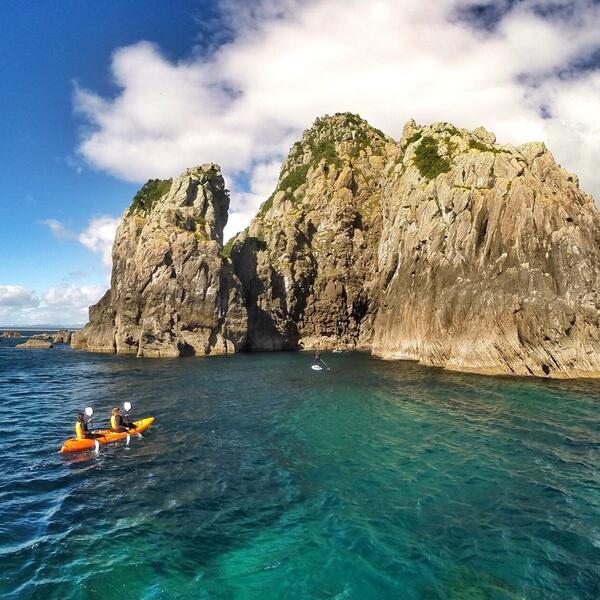
Bay of Plenty Attractions long-arrow-right
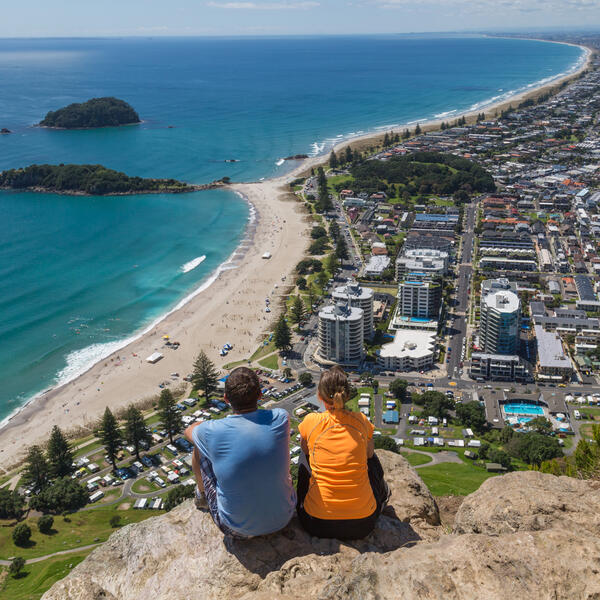
Bay Of Plenty long-arrow-right
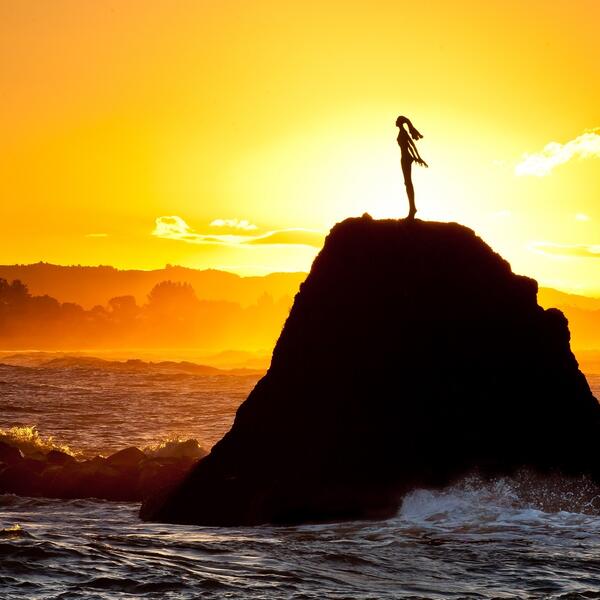
Whakatāne long-arrow-right

Whakatane Information
Search form, you are here, white island.
White Island (Whakaari) is an active volcano, situated 48 km from the coastal town, Whakatane. The island is the largest of the four islands in the Olive island chain. It is roughly circular, about two km in diameter, and rises to a height of 321 m above sea level. However this is only the peak of a much larger submarine mountain, which rises up to 1600 m above the nearby sea floor. As a result of the eruption, on-land tours of the island are prohibited. There are birds eye view tours of Whakaari / White Island available with local helicopter and plane tour guides.
You can monitor the Volcano and view the live web camera by clicking here.
See below for a list of White Island tour operators in Whakatane who can get you closer to the real thing.
Spotlight White Island Listings
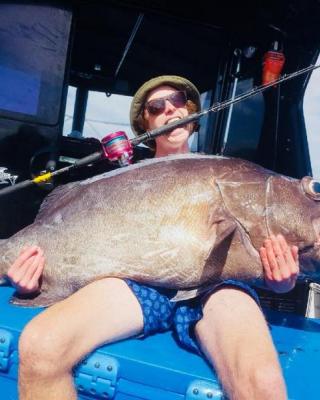
CLUB TALK CHARTERS
Club Talk Charters offer Day Charters to White Island, Opotiki Mussel Farm or Waihau Bay.
Featured White Island Listings
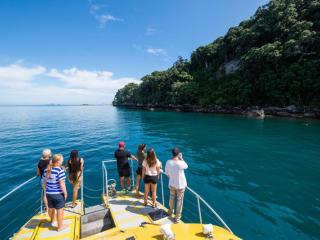
MOUTOHORA ISLAND SANCTUARY
Tours of Moutohorā (Whale Island) - one of New Zealand’s little-known treasures, departing from Whakatāne.
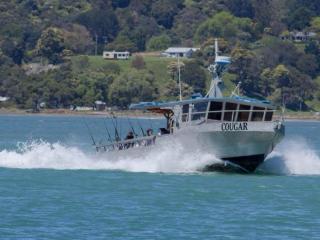
OHIWA FISHING CHARTERS
Ohiwa Fishing Charters are doing fishing trips for individuals or sole charters, from Ohope Wharf out to the Opotiki Mussel Farm.
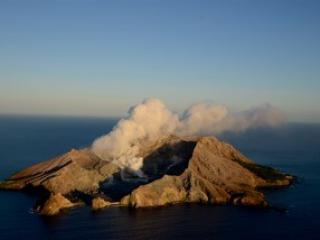
WHITE ISLAND FLIGHTS
On route to White Island get full commentary, exceptional service, safety, and great value ensure you get the most from this experience.
White Island Listings
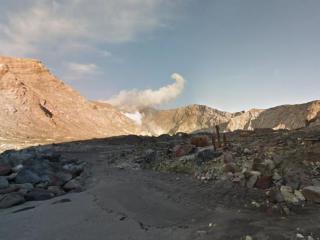
GOOGLE STREET VIEW WHITE ISLAND (WHAKAARI)
Go on a virtual tour of White Island (Whakaari) using Google Street View.
White Island is an active volcano situated in the ocean 48km from the township of Whakatane, Bay Of Plenty, New Zealand. White island attracts visitors from all over the world including a variety of sea life. Get a taste of what White Island has to offer by taking a virtual tour today.
White Island Map

- Accommodation
- Attractions
- Destinations
- About New Zealand
New Zealand Coach Tours
NZ's largest range of coach tours at the best prices !

NZ Self-Drive Tours
NZ's largest range of great value self-drive holidays

Discover New Zealand
Touring holidays designed just for you by our team of locals

Thrifty Tours - Depart Daily
NZ coach tours for every budget!

New Zealand Road Trips
Let's go on an adventure

Ski New Zealand Holidays
Queenstown, Wanaka, Mt. Hutt and Tekapo ski packages plus more...!

Tailormade NZ Tours
Unique touring holidays with premium service

New Zealand Tours
The best in New Zealand Coach Tours

Relaxing Journeys
Choose from over 500 New Zealand tours
Whakaari/White Island Tours
Whakaari White Island tours offer unique experiences to help make your vacation perfect. Take a tour in Whakaari White Island and let your tour guide show you the very best of New Zealand, while combining it with your chosen activity. Whakaari White Island tours may include a relaxing cruise, a food or wine tour, escorted tours, package tours, adventure tours, motorcycle tours, train tours and PGA golf tours. more
If you have a love for the outdoors, New Zealand is the ideal destination for you. Take a 4WD tour, explore the off-beaten track with a tour guide, hire a motorhome and travel Whakaari White Island with a group, or join a dive tour and explore the beautiful oceans.
- All Results
Select by Category
Ezyfishing charters - bay of plenty.
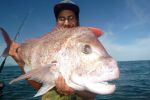
A Kiwi Bay of Plenty Fishing, mussel farm fishing, and Hunting business that lets you choose between saltwater or freshwater fishing or local hunting. Novice or experienced. Lindsay will teach and share his childhood passion in and around Whakatane, White Island, Whale or Raurimu Islands and Rotorua and Taupo Lakes. Trout, Snapper, Kingfish, all gear supplied.
NEW ZEALAND PHOTOGRAPHY WORKSHOPS - New Zealand
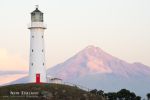
Mobile-friendly - Join New Zealand's top landscape, nature and wildlife photographers to help you to get the most from your photography or visit to New Zealand. From 1-day Photography Workshops to 17-day NZ Photo Tours with New Zealand's leading landscape and wildlife photographers.
NEW ZEALAND SELF DRIVE TOURS - New Zealand
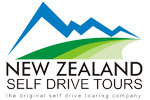
Mobile-friendly - At New Zealand Self Drive Tours we can custom design your perfect New Zealand holiday package. With over 200 different tour suggestions, every one of our self drive itineraries are 100% customisable, allowing you to incorporate any of our excellent range of activities and accommodations. Chat with our New Zealand travel experts to begin crafting your dream New Zealand holiday!
EZYFISHING CHARTERS
Bay of Plenty
NEW ZEALAND PHOTOGRAPHY WORKSHOPS
New Zealand
NEW ZEALAND SELF DRIVE TOURS
Select by map.
This New Zealand map does not display any listings on the map itself but may provide navigation by clicking on map symbol. Alternatively select a category or a region from the main links to find and view tourism businesses.
Select by Location
White Island Tours

- See all photos

Similar Experiences

Most Recent: Reviews ordered by most recent publish date in descending order.
Detailed Reviews: Reviews ordered by recency and descriptiveness of user-identified themes such as waiting time, length of visit, general tips, and location information.
White Island Tours - All You MUST Know Before You Go (2024)

White Island Scenic Flights
For an experience that lasts a lifetime.
Embark on a journey like no other as you glide gracefully above New Zealand’s dramatic terrains and scenic coastlines. White Island Flights offers you the unique opportunity to view the beauty of Aotearoa from a vantage point few get to experience. With our experienced pilot and top-tier aircraft, you can enjoy a comfortable, safe, and visually stunning ride.
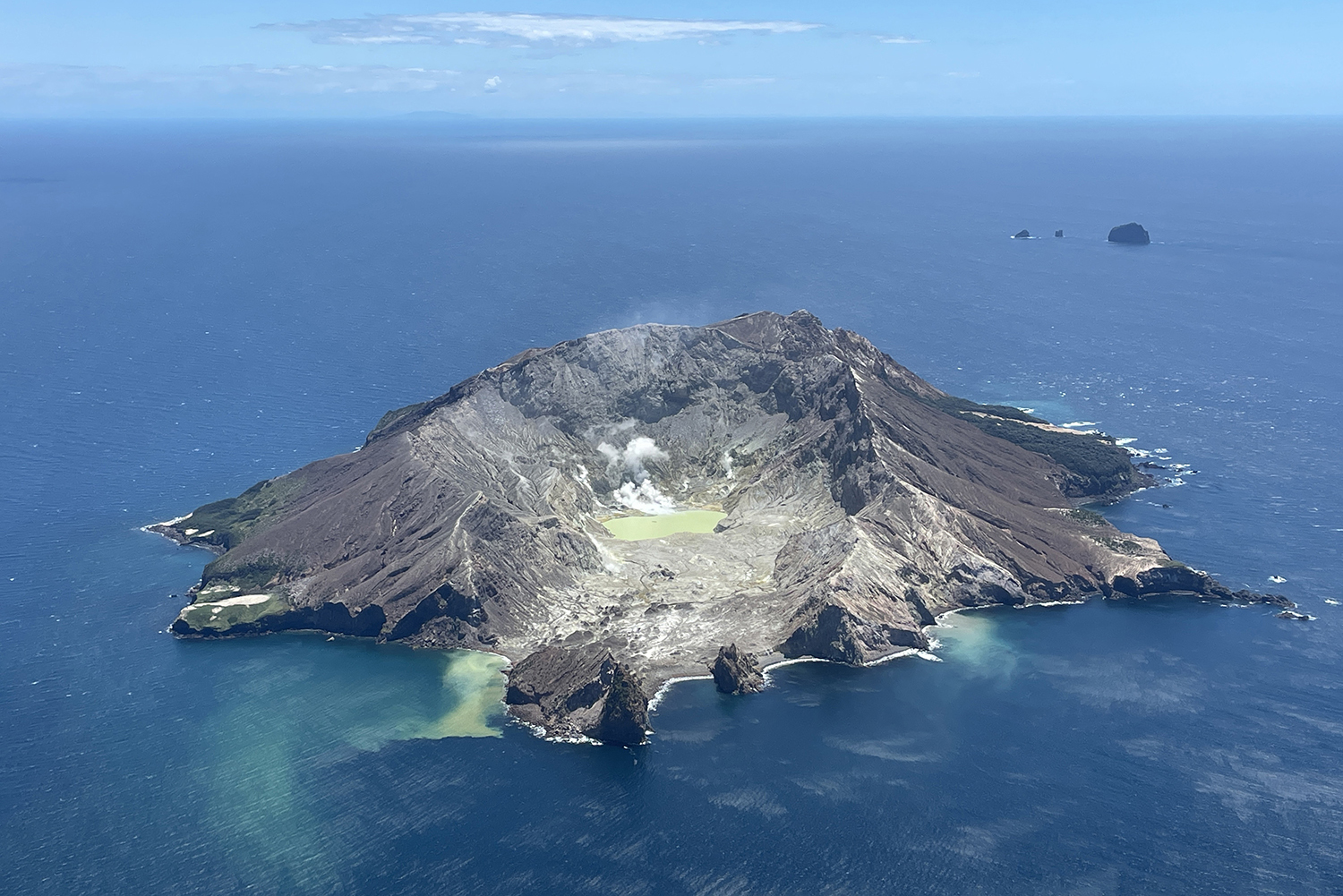

WHITE ISLAND – MT TONGARIRO – MT RUAPEHU – EAST CAPE
New zealand scenic & volcanic flights.
Explore the best New Zealand has to offer through our range of scenic tours. Enjoy a bird’s eye view as we soar above volcanoes, tranquil, untouched beaches, or majestic peaks – our tours offer something for everybody. Whether you’re on a once-in-a-lifetime holiday to New Zealand or celebrating a special occasion, our flights are the perfect addition. Grab a gift voucher for family or friends, or book your very own White Island Flight today!
Gift a Flight
Looking for a special way to celebrate someone special? Why not gift an experience!
A birthday, an anniversary, or simply a token of appreciation, our flights are a gift they’ll never forget.
Private Charter Flights
At White Island Flights, our Private Charter service gives you the freedom and flexibility to tailor a flight path to suit you. Whether you have a specific itinerary in mind or want a private journey for your group, we've got you covered.
Call us now to book your private charter.
Matador Original Series
How to see volcanic whakaari/white island in new zealand.
W hakaari, or White Island, is a volcanic island in the Bay of Plenty off the east coast of New Zealand’s beach-covered North Island . It’s the most active volcano in New Zealand and one of the most studied volcanoes in the world. Whakaari has been active for at least 150,000 years, with frequent eruptions throughout its history. Whakaari has had several deadly eruptions over the past 200 years, including an eruption in December 2019 that killed 22 people.
If you’ve watched the recently released Netflix documentary The Volcano: Rescue from Whakaari , you know that it’s not a place to underestimate.
Because of this, Whakaari/White Island is currently closed to tourists , but you can still do scenic flights over the island. So here’s what to know about scenic flights over Whakaari/White island, plus what to know when or if it opens for hiking tours once again.
Where is Whakaari?
Whakaari/White Island tours
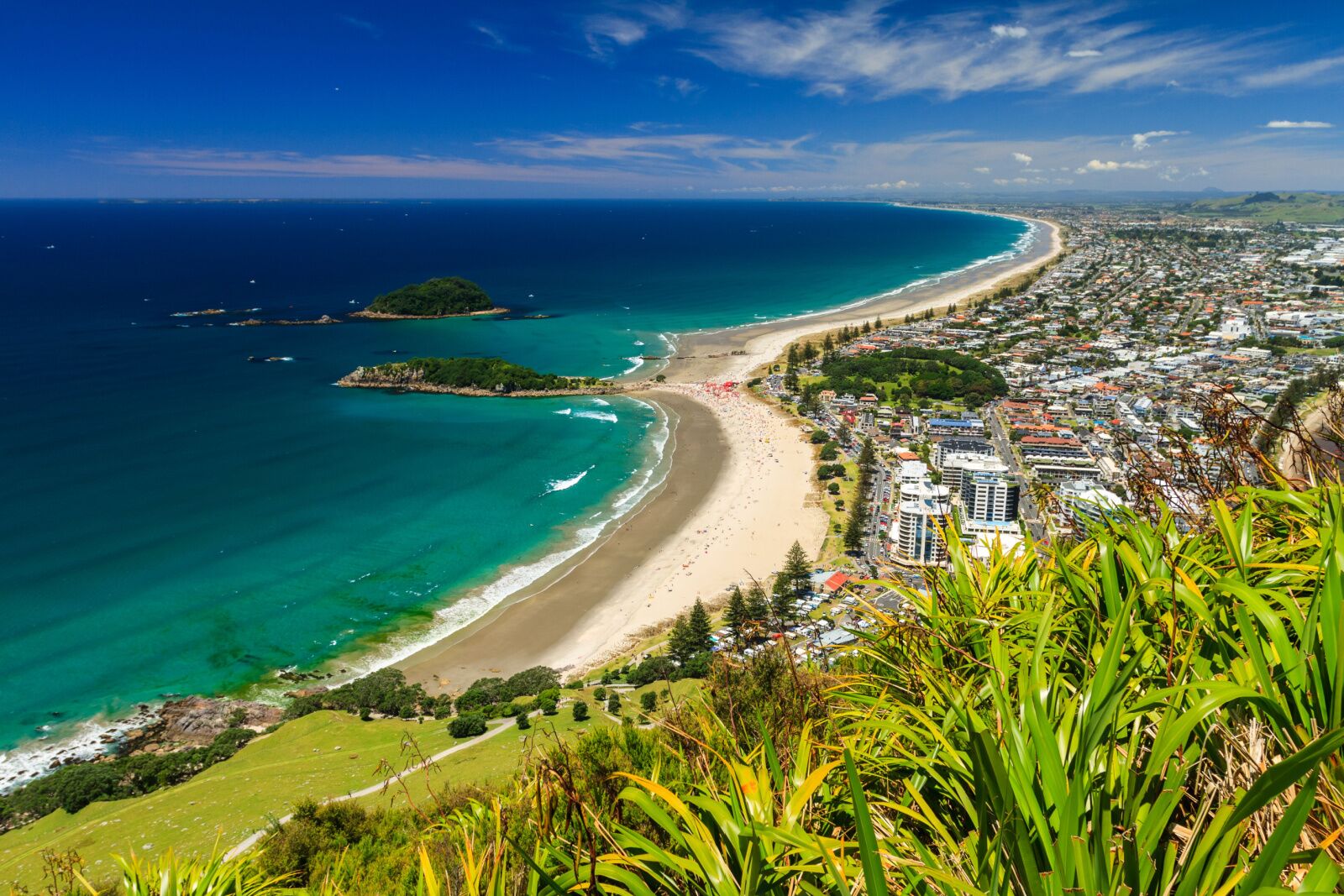
Tauranga, New Zealand. Photo: Tauranga /Shutterstock
Whakaari/White Island tours typically leave from Whakatane (a four-hour drive from Auckland) or Tauranga (about three hours from Auckland). Whakatane is the closest mainland town to Whakaari and is the most popular departure point for organized tours.
When exploring the island on foot is allowed, you can book trips from several area tour companies, some of which offered the opportunity to camp on the island (and may again whenever it reopens).
When the island is closed to foot traffic, seeing the island from air is the only option. But that’s no problem, since seeing it from air may give you the best perspective of the uniquer island (and save you from smelling some seriously strong sulfur). White Island Flights offers scenic flights over Whakaari, offering stunning views of the iconic landscape from up high. Hour-long tours start at $249 NZD, or about $159 US.
What will you see at Whakaari?

Photo: Jeff C. Photostock /Shutterstock
Whakaari/White Island offers some truly unique experiences for its visitors. Aside from the active volcano itself, there is a variety of geographical features including hot springs, fumaroles, craters and steam vents where one can observe the active processes of Whakaari. Fortunately, it’s easy to see all of these from the air.
Whakaari also has its own unique fauna and flora, with several species that are endemic to the island. The extreme environment has led to some unique evolutionary adaptations, and species you’ll see there include the Whakaari skink, Whakaari gecko, and Whakaari cicada.
Is Whakaari safe?
Whakaari/White Island is an active volcano, and as such visitors must take extra safety precautions. All trips to Whakaari should be organized through reputable companies that have experience dealing with volcanic activity and know the risks associated with it. It is also important to check in advance if there have been any recent eruptions or seismic activity. When the island is closed to foot traffic, never try to charter your own boat. Planes and helicopters can make quick getaways if they notice any unpredictable seismic activity; hikers can’t. Be smart.
Whakaari eruptions
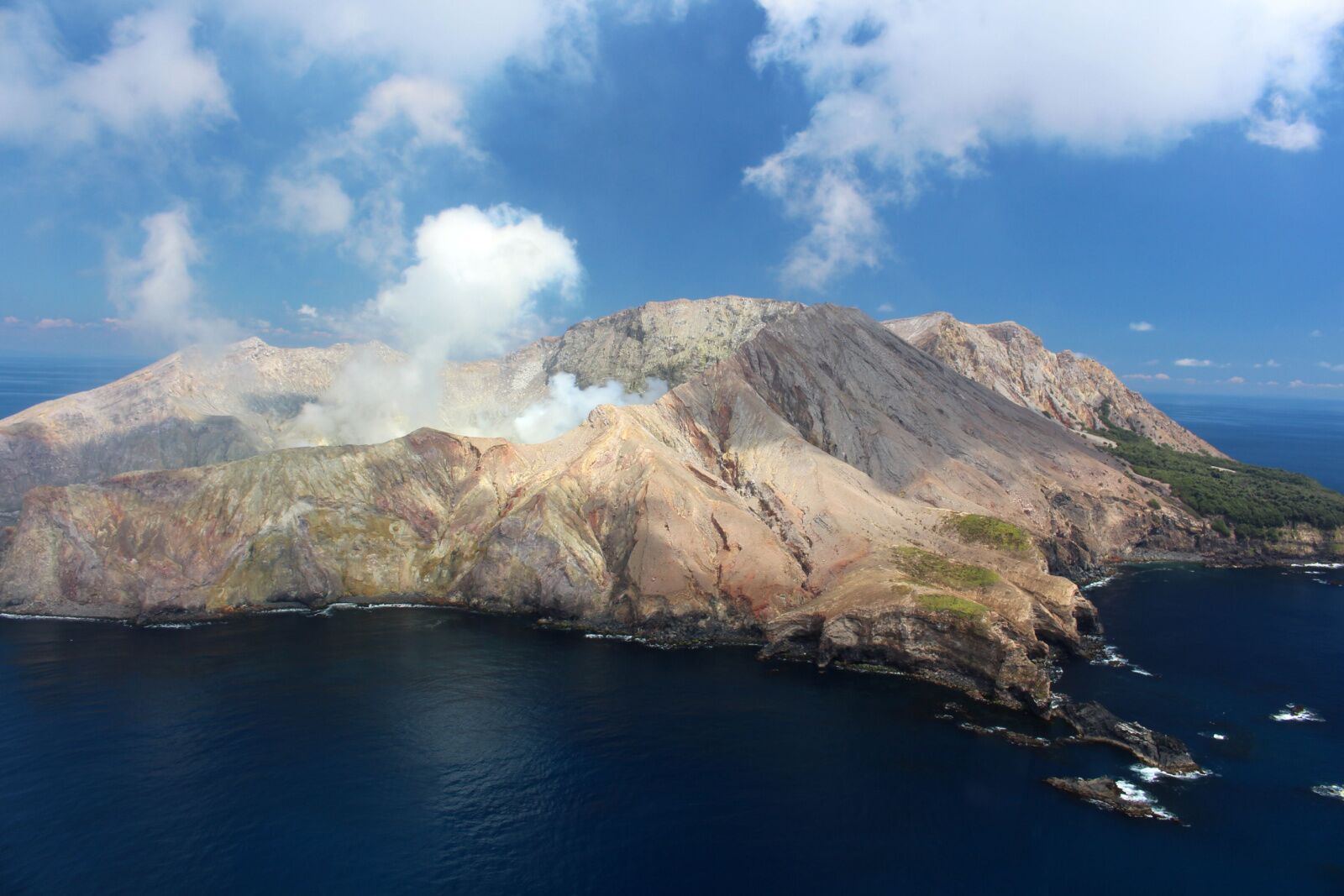
Photo: Jet 67 /Shutterstock
Whakaari has had several explosive eruptions over its long history, producing pyroclastic flows and ash plumes that have the potential to disrupt air travel in the region. Whakaari is monitored 24/7 by GeoNet, a government agency tasked with monitoring volcanic activity in New Zealand. The most recent major eruption occurred on December 9th 2019, and Whakaari has also had several smaller eruptions since then, including one as recently as March 2021. Scientists continue to monitor Whakaari’s activity and will close foot traffic to the island during periods of extended activity (which is the case as of December 2022).
When will Whakaari/White Island reopen?
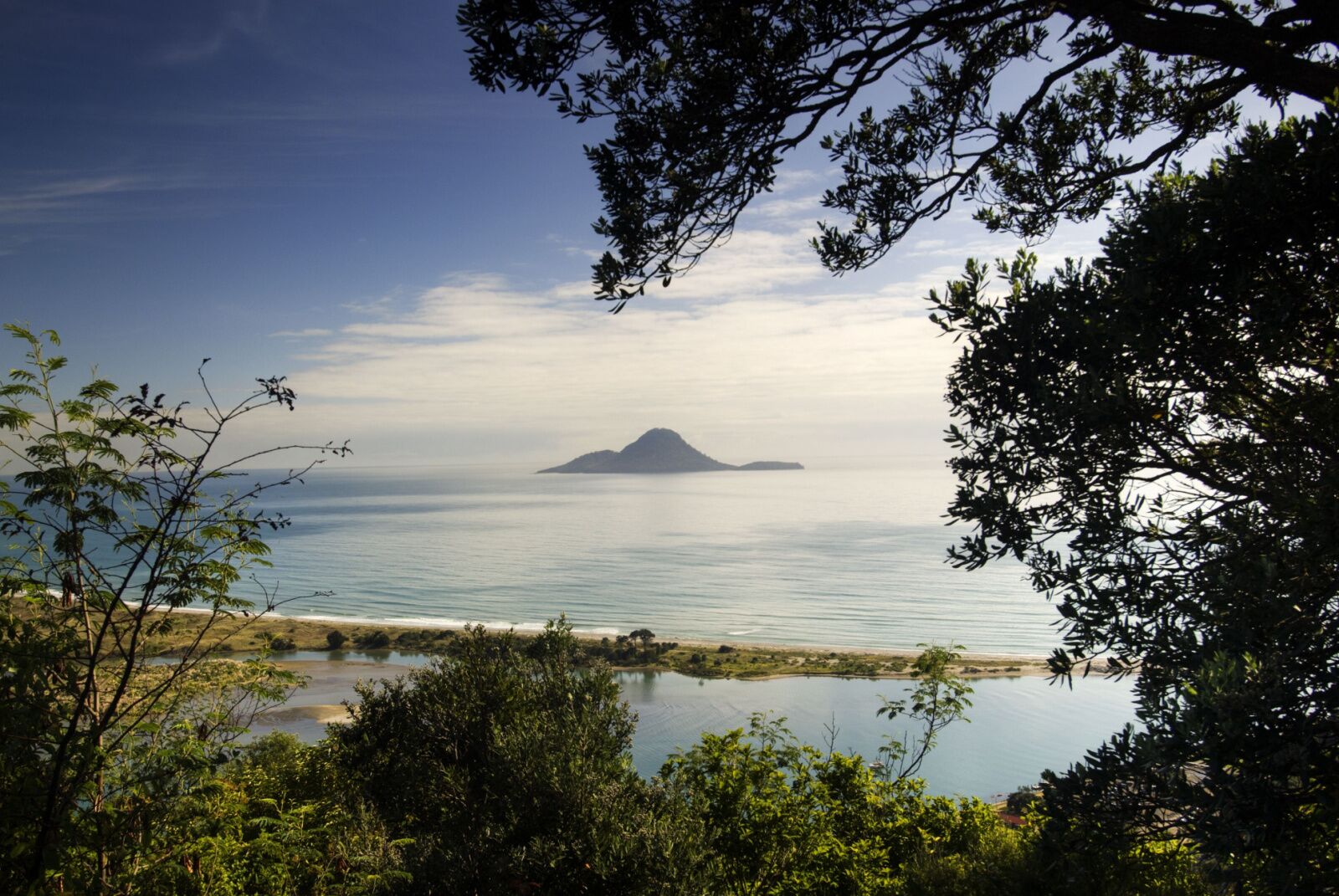
Photo: Photo Image /Shutterstock
Whakaari remains closed to visitors as of January 2023. The question of when it will reopen is a difficult one and is still uncertain. Whakaari needs to be assessed for the short-term impact of the eruption and potential long-term effects on its geology and environment before any informed decision can be made.
More like this
Trending now, 7 places for the best lake diving in the us, the best eco-friendly men's mountain biking gear for your next ride, bike trails in gunnison and crested butte, co: from singletrack to gravel rides, norway's newest thrill: terrifying rope ladder offers breathtaking views 790 meters above a fjord, lift-serviced bike parks: what to know before your first visit, discover matador, adventure travel, train travel, national parks, beaches and islands, ski and snow.
We use cookies for analytics tracking and advertising from our partners.
For more information read our privacy policy .
Matador's Newsletter
Subscribe for exclusive city guides, travel videos, trip giveaways and more!
You've been signed up!
Follow us on social media.
- Science & Environment
History & Culture
- Opinion & Analysis
- Destinations
- Activity Central
- Creature Features
- Earth Heroes
- Survival Guides
- Travel with AG
- Travel Articles
- About the Australian Geographic Society
- AG Society News
- Sponsorship
- Fundraising
- Australian Geographic Society Expeditions
- Sponsorship news
- Our Country Immersive Experience
- AG Nature Photographer of the Year
- Web Stories
- Adventure Instagram
What really happened on Whakaari/White Island?

THE ERUPTION BEGAN at 9.35pm with big heaves inside the crater. By 10.03pm it was pelting the nearby walking track with projectiles, but withheld its final energy until 10.11pm, when with a whoomph it sent a plume sky-high. A scalding current of steam and debris, coloured green by hydrothermally altered rock, rolled right across the track at 11m/s, and down to the south-eastern bays.
This eruption took place on Whakaari/White Island, New Zealand, on 27 April 2016, more than three years before the catastrophe in December last year that claimed the lives of 21 people (17 of them Australians) and injured 26 others.
Geologists from GNS Science, NZ’s leading provider of geoscientific research, reconstructed the pulses of the eruption from acoustic and seismic data, and, three weeks later when they could safely land on the island again, began figuring out the reach of those pulses.
The resulting scientific paper was published on 1 April last year, and its authors warned: “These eruptions clearly pose a significant hazard to the tourists that visit the island.” More than a quarter of the walking track had been bombarded by rock fragments. The pyroclastic surge, though just 5mm thick at its extremities, had nonetheless covered 95 per cent of the track.
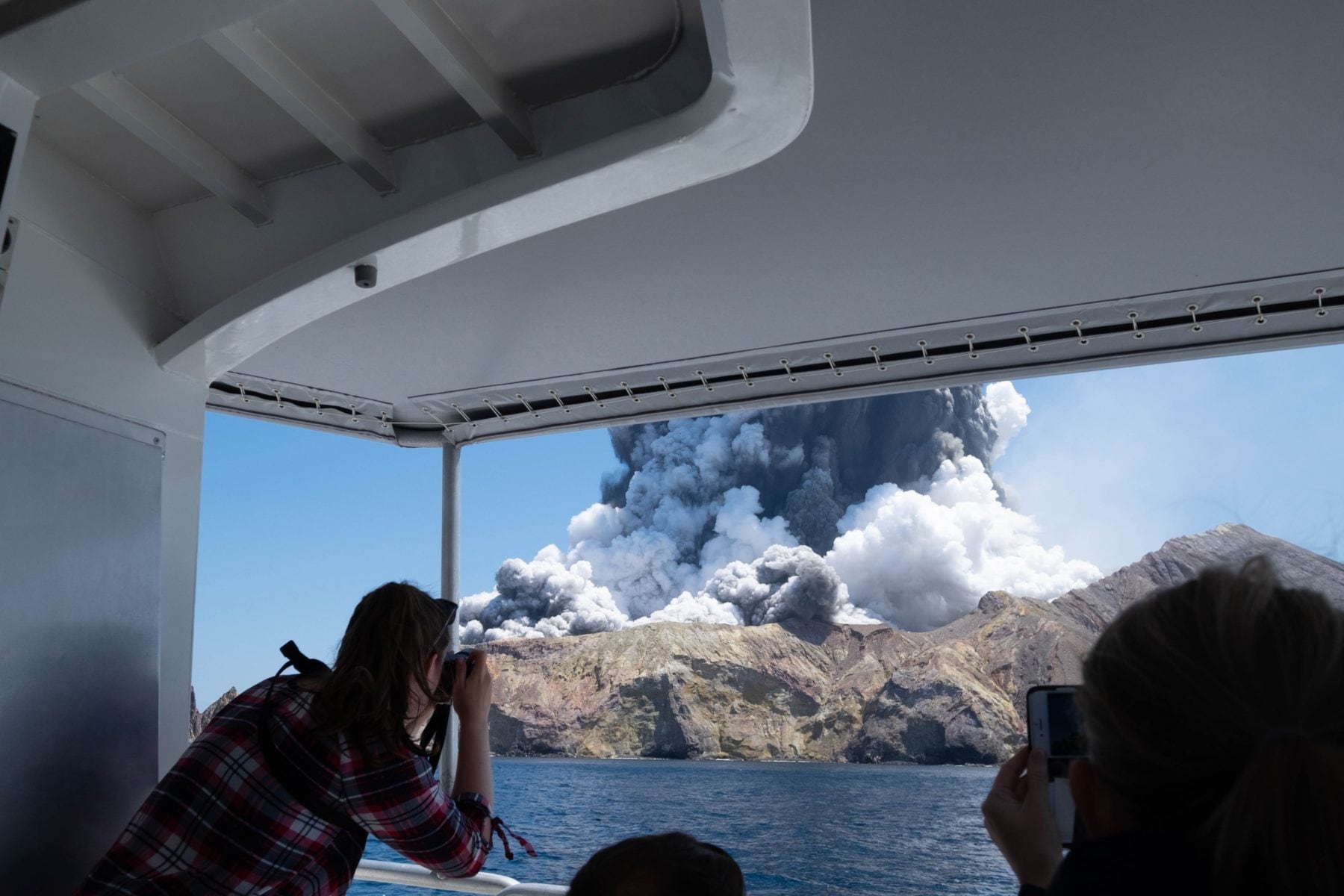
You might wonder if this eruption triggered any changes, but it happened at night, with no witnesses, so it simply passed on by. You might, therefore, be tempted to wish it into the daylight, when tourists would have been afoot, because then it might have garnered more notice – since it came in pulses of ascending violence, there would have been time to run, and the headlines would have been nothing more than “Tour operators reassess risk after near miss”. It would have been a wake-up call that produced only meetings over cups of tea, with scribbled notes, bottom-line business interests weighed against risk, and some kind of agreed reform.
Three years later, at 2.11pm on 9 December 2019, there was another eruption – one that came without warning. Except, perhaps, that on 8 December the instruments that measure tremors in nanometres momentarily spiked 30 per cent higher than any tremor during the previous two months. Or perhaps for a moment during a video shot by tourist Allessandro Kauffmann earlier in the afternoon. Kauffmann was part of the group aboard Phoenix , a White Island Tours vessel, and he videoed much of the island tour. At about 1.30pm, he panned along the hot, strangely bright stream flowing from the crater lake. Amid the snap and spit of boiling mineral water, the microphone caught an off-camera aside by a White Island Tours guide: “I’m a little bit worried why it’s going green.”
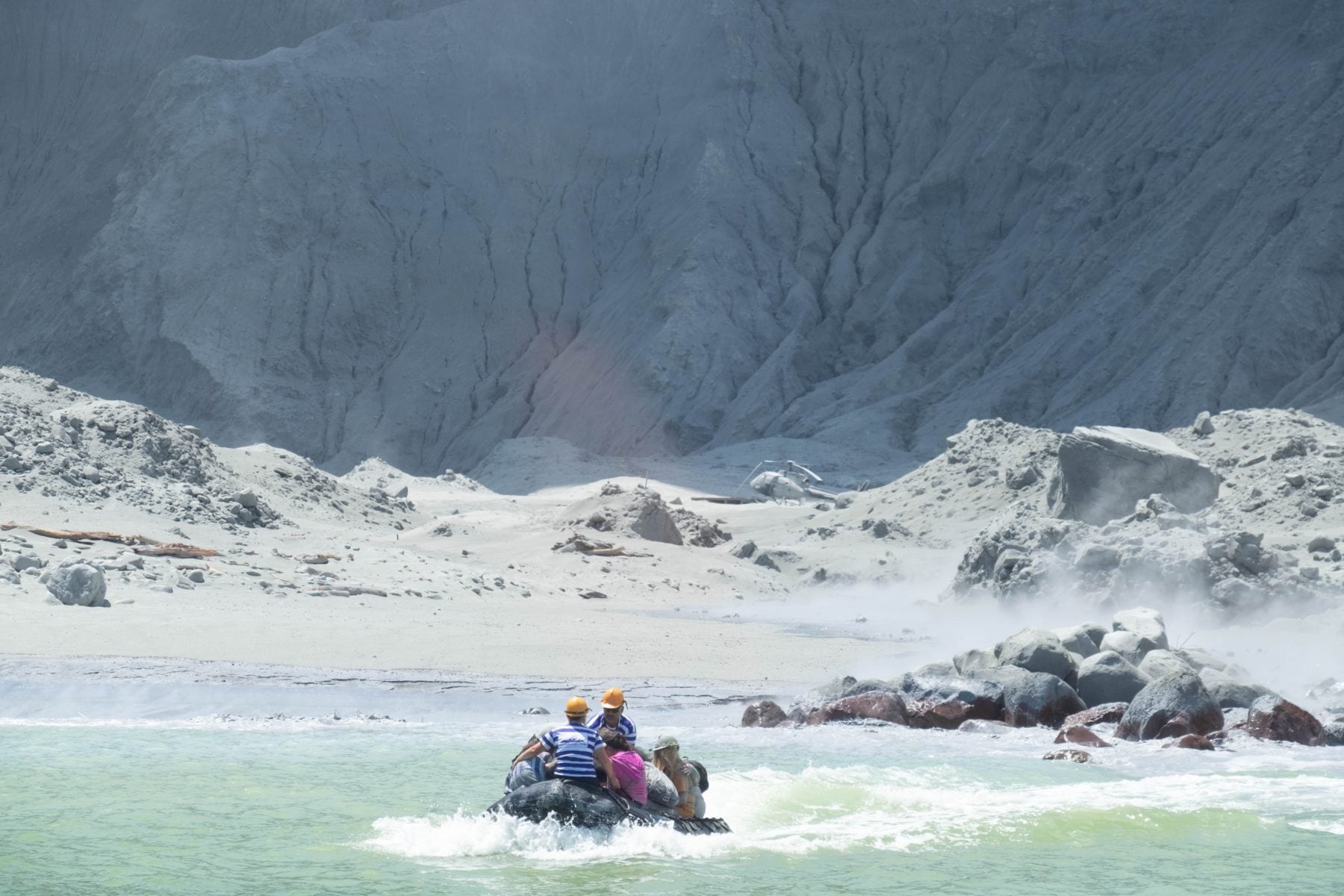
Whakaari’s dangerous charm
Attitudes to Whakaari have long been cavalier. In 1914 miners drained the crater lake to uncover deeper deposits of sulphur. Geologists suspect this affected the stability of the crater cliffs, because in September that same year, a 300m-wide chunk collapsed. As it fell, the rock, weakened by heat and saturated with water, mutated from an avalanche into a highly fluid lahar (a violent type of mud or debris flow), which ran for more than 1km eastward to the sea, burying the 11 miners and destroying the sulphur factory.
Then, during Whakaari’s long eruptive phase from 1976 to 1982, the keen young geologists of the NZ Geological Survey’s Rotorua office put together the first comprehensive analysis of the volcano’s mighty hydrothermal systems. They were often photographed as minute specks against vast up-rushing columns of steam, or in front of dark umbrellas of mud thrown up by the vents. They were out there for hours, measuring the gradual expansion or contraction of the crater floor, even when the volcano was – to use their word – “ashing”, the grey flakes coating their hair and clothes.
“We took risks and didn’t even think about it,” says Ian Nairn, who was one of that group. “We often went out straight after a serious eruption. It was our job, our interest, and the main problem was how long it took to organise a boat or a helicopter.”
Peter and Jenny Tait first became similarly transfixed by the volcano’s dangerous charm when they took a group from Germany on a fishing charter, but, at the Germans’ impulsive request, finished up exploring the island. The Taits built a business out of taking tourists to stand at the junction of the real world and the unruly energy of the underworld: the strange colours, the steaming lake, the crater cliffs painted bright yellow at their base and then rising almost vertically to 300m, cupping the humans below within a thrilling amphitheatre.
“That first trip was in 1990,” Tait tells me, “and, as it developed, Jenny and I were taking six people a day there. It was very personal. The reaction of the punters was, ‘It’s unbelievable,’ and that’s what drove us to keep developing it.”
In 2017 the Taits sold their business, White Island Tours – a 27-year-old enterprise that came with a motel and cafe – to Ngati Awa Group Holdings, which kept on many of the Taits’ employees.
“Safety?” Tait says, when asked about the potential risks of taking visitors to an active volcano. “We were more worried about the Whakatane River bar than the island erupting, to be honest. There were so many things. It was an adventure trip. You have to cross the river bar. You have to cross pretty rough ocean, then get into an inflatable and land, with very tricky conditions, to get onto the island at times. And you’re on the island a very short time, really. The overall chances of it erupting seemed pretty small.”
On the afternoon of 9 December, Tait was sitting in his lounge, high on the rocky ridge that overlooks Whakatane and out across 50km of blue ocean to Whakaari. He saw the eruptive column’s silent rise. He didn’t know if there were people on the island or not.
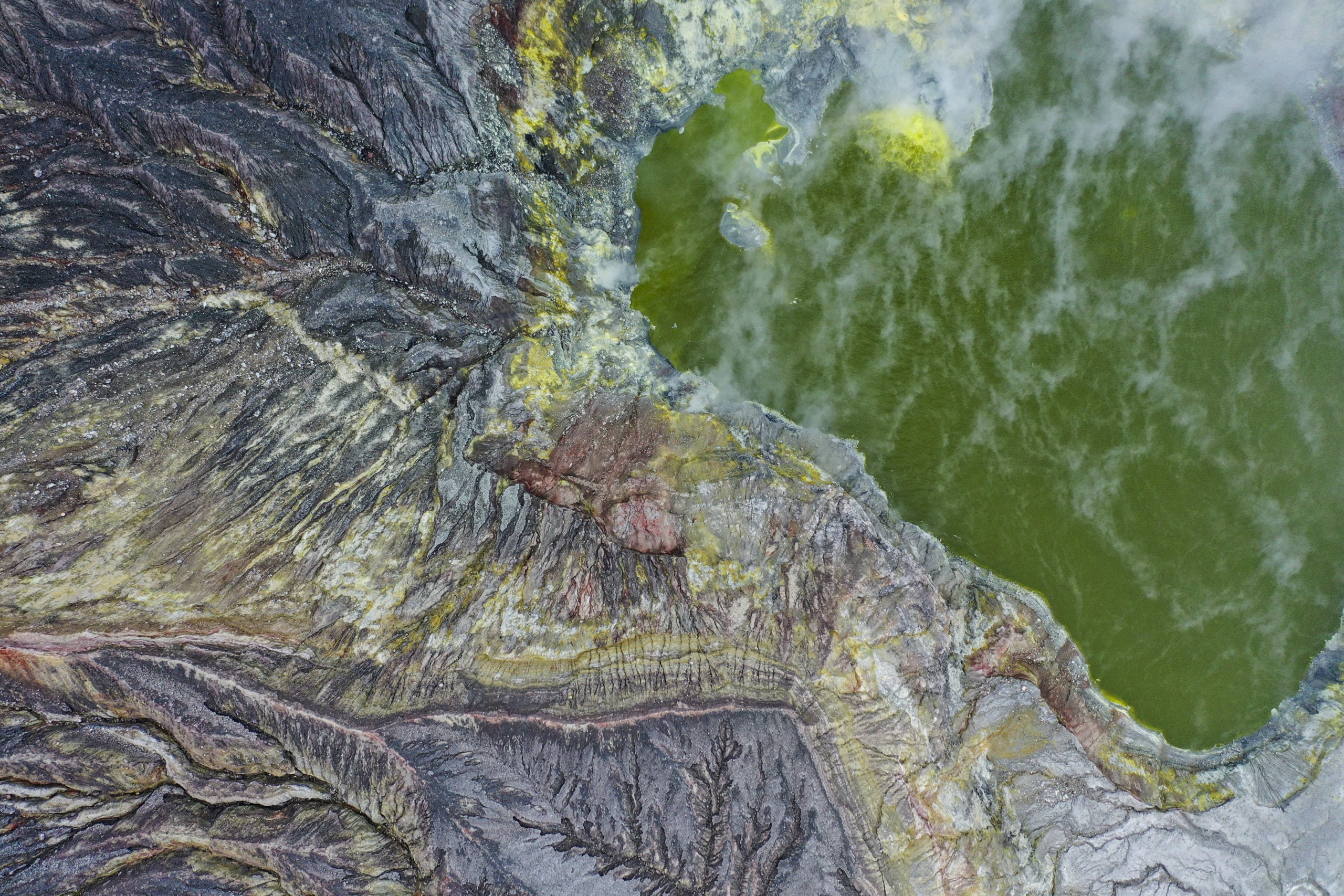
The rescue mission
Those aboard Phoenix knew. At about 2pm, passengers had returned to the vessel, which was moored in Te Awapuia Bay on the south-eastern corner of the island. Phoenix motored north around Troup Head, giving its passengers one last photo opportunity directly up the crater, before it turned south to return to Whakatane.
It was right at that moment, to gasps of pure wonder, that the eruptive column boiled into the sky. Then the column darkened at the base, and a sinister ground-hugging wave steadily overwhelmed the island, billowing towards the vessel. The framing on every camera went up, down or sideways, jerking with fear.
The skipper accelerated clear of the ash cloud, and for his passengers the eruption was no more than a terrible fright. But there were people on board who knew that White Island Tours’ new flagship vessel, Te Puia Whakaari , was still moored back at Te Awapuia Bay, and that its tourists were still on shore. That meant 38 passengers from the cruise liner Ovation of the Seas , plus four guides.
Meanwhile, the Rotorua-based company Volcanic Air had brought four tourists to the island on a Squirrel helicopter that the company’s pilot and guide had set down on a landing pad behind the ruin of the sulphur factory. That made 47 people still on the island.
At 2.14pm, Phoenix sent out an emergency call to Coastguard Whakatane, advising of an eruption and requesting urgent medical evacuation. Phoenix then sped back to Te Awapuia Bay, and called the coastguard again at 2.16pm, confirming casualties. Minutes later, Te Puia Whakaari also contacted the coastguard. The three calls triggered a Civil Defence emergency, alerting police, St John Ambulance services, rescue-helicopter services and hospitals on the mainland.
But Whakaari lay across 50km of rough ocean, far from any immediate help. As national agencies began to tool up, the locals were already organising their own ship-to-shore and air-to-ground rescues.
At Te Awapuia Bay, the ash had already cleared. The sky was once again blue and the sun shone, but Te Puia Whakaari and the island itself were a dull, flat grey. Phoenix ’s skipper kept his engines running, ready to speed clear if the volcano blew again.
Paul Kingi was a senior skipper and the tours manager at White Island Tours, but he’d joined Phoenix that morning simply as a guide and was free of any captain’s responsibility to stay with the vessel. He took immediate charge of the rescue, loading two crewmates into Phoenix ’s inflatable, then gunning its motor to intercept a woman swimming towards Te Puia Whakaari . After plucking another two women from the water, he took all three to Phoenix . Then he turned to the dozen or so people, grey with ash, who were huddled on or near the island’s landing.
As the sea-to-shore rescue got underway, an air-to-ground rescue was assembling. The rising plume from Whakaari had served as a shrill alarm for pilots from Whakatane, Rotorua and Taupo. Mark Law, head pilot of Whakatane-based helicopter operators Kahu NZ, saw the eruption as he drove back from Tauranga in his car. He got on the phone, and the Kahu base confirmed that GNS Science’s monitoring cameras on the island had blanked out. Simultaneously, high above the blue expanse of the Bay of Plenty, a helicopter pilot who had lifted off from Whakaari just six minutes earlier called his head pilot, Tim Barrow, at Volcanic Air, and described the scale of the eruption. Barrow then called Law.
Meanwhile, retired helicopter rescue pilot John Funnell was in the air in a small fixed-wing aircraft near Whakatane, keeping up his flying hours. As two Kahu choppers prepared to lift off for Whakaari, with pilots Law, Jason Hill and Tom Storey aboard, Funnell was enlisted as ‘top cover’, a specific role within emergency operations – the top cover is the fixed-winger that circles high above the scene and transmits information received from the team below.
So a small airborne unit was formed, bound together not by official roles or rehearsals, but by the natural meshing of grave concerns and aided by local knowledge of landing pads within the crater.
By then, the sea-to-shore rescue was closing up, and Phoenix had become a de facto hospital ship. Kingi’s inflatable had delivered the people on the landing to the vessel, including the four Volcanic Air tourists and their pilot. Three of those five were probably the luckiest people on the island that day, because when the volcano blew they were already at the shoreline, the last point of interest in their hour-long tour. The pilot urged them into the water, and he and the two who immersed themselves escaped serious injury. The other two hesitated, and were later hospitalised for burns.
Kingi, back on the island, had gone inland on the walking track towards the crater to find more survivors and help them down to the inflatable. The last person Kingi found, just as he had decided to stop searching, was 19-year-old Australian Jesse Langford, who stumbled down towards him. Jesse had been more than 300m inland when the volcano blew. He was his family’s only survivor, because his father, Anthony, mother, Kristine, and sister, Winona, passed away around him.
At about 2.45pm, Phoenix took off for Whakatane. The Kahu helicopters above and the vessel below crossed paths just before 3pm, and Law swooped low, the urgency of his mission and the scale of it confirmed by the sight of prone people being tended to on the back deck.
Those who had sustained the worst burns had been placed at the front of the vessel, and two doctors had stepped forward from among the passengers to tend to them – a general practitioner on holiday from the UK, and another from Germany.
Geoff Hopkins, a pastor at Arise church in Hamilton with a St John certificate, also provided assistance. He dug deep into remote first-aid training he’d done in the UK, but he was dealing with people drifting in and out of consciousness, people who were saying, “I’m not going to make it.” So he dug deeper yet, into his faith, and told them, “You’re not going to give up.”
His daughter, Lillani, was at the back of the vessel with the other victims, doing her best to stave off hypothermia and shock. She found herself singing the evangelical song “Waymaker”:
You are here – moving in our midst…
You are here – working in this place…
You are here – healing every heart…
And if she stopped there’d be a touch on her leg, and a whisper: “Keep singing.”
Halfway back, Phoenix was met by a coastguard vessel delivering paramedics and pain-relief medication.
About 3pm, the Kahu helicopters entered the crater airspace, and Law descended to 200 feet for a closer look. The centre of the island was now mostly clear of steam and ash. He saw some figures lying down, and others sitting – there were people alive down there. The Kahu pilots set their choppers down on the crater floor and got out of their machines, scuffing through the grey ashfall, amid dense gases and drifting ash.
Breathing was difficult, even with gas masks. They assessed the dead, the dying and the living. Through a handheld radio – they had to remove their gas masks to speak into it – they described injuries to Funnell, their top cover, who relayed the information to Whakatane Hospital.
The fliers felt the desperation in everyone they encountered, and their response was to talk back, to comfort, to tell each person, “We’re here. We’ll get you out,” before moving on to the next person. Law got word that the big air ambulances were still being staged at Whakatane, so any immediate rescue was up to them. The most badly injured – by ballistics as well as scalding – were those nearest the crater. The Kahu team hopped one of the choppers further up into the threatening miasma to get them, loaded five people, and Hill took off for Whakatane Hospital. Below him, out of the steamy cauldron that had produced the lethal blast, the volcano suddenly started ashing.
By now, it was about 3.40pm, and Barrow was settling his helicopter onto a landing pad by the shore. He’d flown in from Rotorua with pilot Graeme Hopcroft. Funnell had updated them on conditions, and they raced up to the crater to join the search. They half-carried one survivor to their chopper, then joined the Kahu crew to assist five more survivors into Law’s machine. Law lifted up and out for Whakatane. Barrow, Hopcroft and Storey loaded one more survivor into the Volcanic Air helicopter, then Barrow and Hopcroft fired it up and banked south for Whakatane.
For a time, Storey was left alone. He spent the next half-hour grouping bodies for later retrieval. Among the bodies was his friend, White Island Tours guide Hayden Marshall-Inman. A second Volcanic Air helicopter arrived to pick up Storey, and completed an aerial reconnaissance of the crater.
By then it was all but over.
Two Westpac air-ambulance helicopters arrived, one circling on standby above the crater, while the second landed St John medical director Tony Smith and three other clinicians on the eerie domain below. They checked the bodies for signs of life, and confirmed no survivors were left behind.
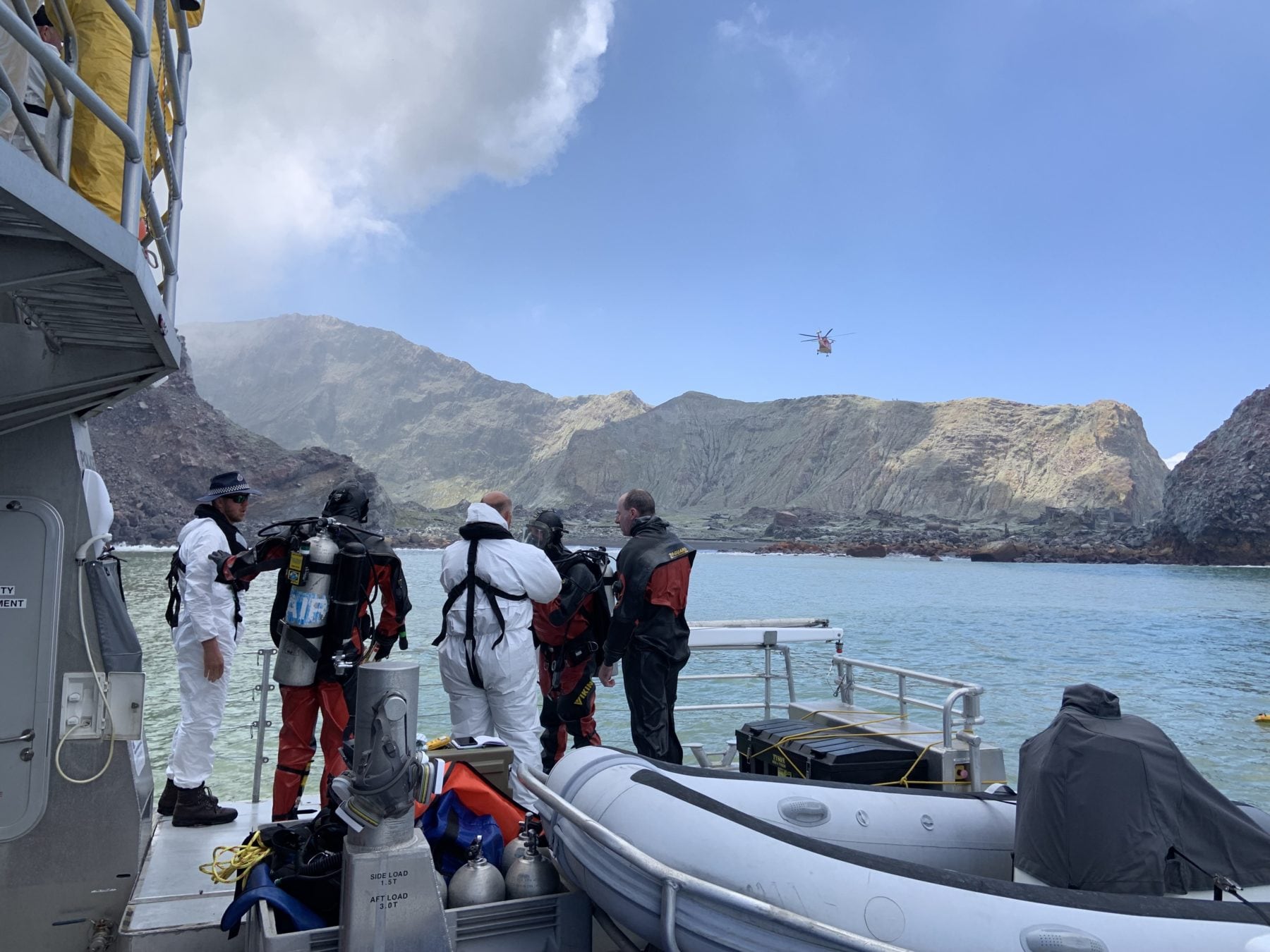
The science behind the eruption
In geological terms, the steam-driven eruption on 9 December was a small one, similar in energy and range to the 27 April event three years earlier. One significant difference was that it happened more quickly.
Shane Cronin, professor of volcanology at the University of Auckland, compares the 9 December eruption to a giant pressure cooker blowing its lid. Whakaari’s “lid” consisted of layers of sulphur, salts and weakened rock, which were metres deep. These were blasted away to form an entirely new vent. When this lid blew, a pressure wave fled across the island at supersonic speed, invisible but forceful enough to knock gas masks off the faces of tourists and guides and to shift Volcanic Air’s 1.3 tonne Squirrel helicopter half off its landing pad.
Then an eruptive column of steam and ash climbed into the sky, perilous to any who stood close by.
But the most lethal event in the eruptive sequence was the third: a dense, ground-hugging pyroclastic surge, which flowed from the vent, over the walking track and right down to the eastern shoreline.
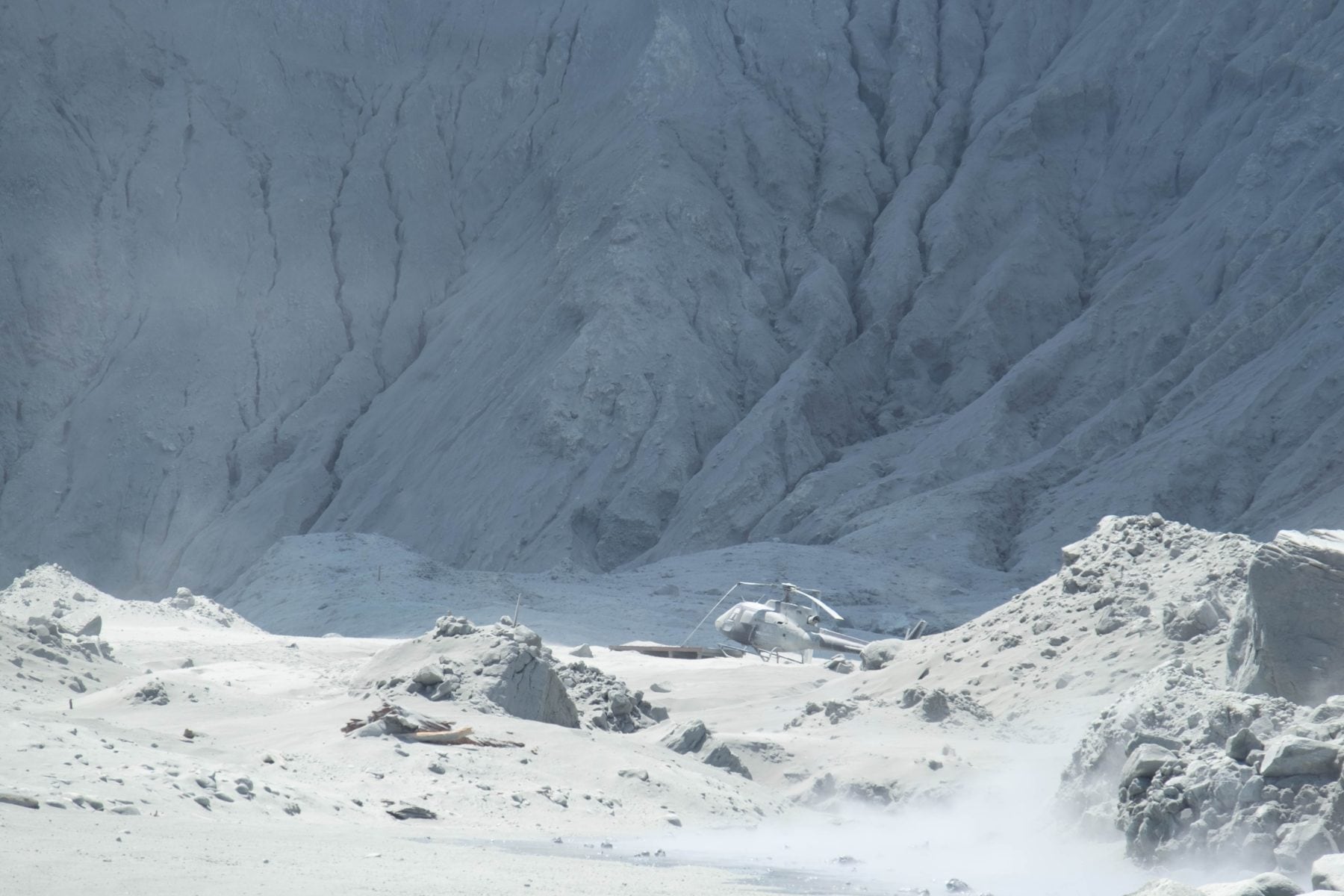
Cronin calculates from past studies of steam-driven eruptions on Whakaari that this surge would have burst from the crater at 300ºC and 100km/hour, losing force and heat in the ambient air as it rolled east. It was still boiling hot but had slowed to about 25km/hour when it flowed into the sea.
The surge was mainly formed of steam and ash, but carried within it a “salty aerosol”, says Cronin. Past testing of residues from this type of eruption has found them to consist mostly of fine fragments of pulverised rock coated in sulphur and acid salts, which turn into concentrated droplets of sulphuric acid when they come into contact with air, water or human skin. The remaining residues are hydrochloric acid and small amounts of hydrofluoric acid, which is the most corrosive of the residues, especially if inhaled.
Although the Squirrel helicopter was 1km away from the eruptive vent, its rotor blades flapped up and down like a bird’s wings in the turbulence of the pressure wave. Then the pyroclastic surge plastered it with ash. Afterwards, it sat stranded in the grey surrounds, grievously damaged, its carbon fibre and aluminium rotors broken and drooping, undone by nature’s power.
Calculating the devastation
The eruption had triggered a national emergency, and leadership had been formally handed to Bay of Plenty’s Civil Defence Emergency Management Group, with police the lead agency for search and rescue, and for recovery. The helicopter pilots had operated independently of the official system, but fell under its command once they landed and were stood down.
Eight bodies still lay on the island, two of them White Island Tours guides – Tipene Maangi and Hayden Marshall-Inman. As public pressure rose by the day to recover the Whakaari dead, Marshall-Inman became a symbol for all eight. The 40-year-old was well liked within the communities of Whakatane and Ohope, and he’d been with White Island Tours for many years.
A sense of frustration was growing in Whakatane, fuelled by outside control swooping in and sidelining local pilots, quarantining tour boats without properly cleaning them of corrosive ash, and suggesting – wrongly – that there was a criminal inquiry into White Island Tours. The town’s diffuse anger found focus on delays in the recovery.
But police were responsible for ensuring no further casualties, and the GNS Science seismometer on Whakaari was laying down a continuous recording of the volcano’s quivering energy.The volcano had erupted out of nowhere, and might do so again. In the hours after the eruption, the island was relatively quiet – and, in retrospect, this was the window for recovering the bodies.
Indications of unrest became more pronounced on Tuesday 10 December when the tremors began again, and on Wednesday and early Thursday the tremors peaked at levels well above the eruption itself. On Thursday evening, the tremors fell away sharply, and continued to fall on Friday, when the NZ Defence Force landed on the island at first light.
It was a team of eight, including six bomb disposal specialists, kitted out in three protective layers, with breathing apparatus and four hours’ worth of air. The work they did was exhausting. Around the active crater area, they waded through dense, hot, acidic mud, but they collected the bodies, and prepared them for final retrieval by helicopter to HMNZS Wellington , which was waiting offshore.
They recovered six bodies, but two had gone. Marshall-Inman and Winona Langford had been 800m away from the eruption, and 300m from the shoreline, but a violent rainstorm had swollen the stream near where they lay, and washed them into the sea. Police would later say that, while patrolling in Te Awapuia Bay, they’d seen a body believed to be Marshall-Inman near the landing, but couldn’t get close enough to recover it, and called in a Navy inflatable. In rebounding waves, the Navy personnel were unable to take the body aboard, and the rough sea allowed no second chance.
Resigned to the lack of any formal goodbye, the Inman family organised a celebration of life at the Whakatane Baptist Church on 20 December. Maangi’s photo was on display, too, and hundreds attended. The mourners heard from the helicopter-pilot rescuers that both Marshall-Inman and Maangi had tried to help members of their tour groups before they’d finally succumbed. Monday 9 December had been Marshall-Inman’s 1111th venture onto the island, and each one of them, except the last, had been recorded in his diary.
A few weeks later, Marshall-Inman’s brother Mark Inman and friends rode jet skis out to Whakaari, and sat on their craft in Te Awapuia Bay. After the long haul out to the island, the eight riders opened cans of beer and performed their own karakia – Maori incantations and prayers, used to invoke spiritual guidance and protection – to their friend and brother, and to all those who’d lost their lives.

Beatlemania: the enduring legacy of the Beatles' tour of Australia, 60 years on
The Beatles began their first and only tour of Australia 60 years ago this week. It remains a landmark event in our social and cultural history.

Australia's space race: From red dirt to the stars
Despite the lack of a strong, overarching national strategy, engineers, scientists, academics and entrepreneurs across the continent have been busy developing Australia into a spacefaring nation, building our modern space industry from the ground up.

Understanding Indigenous DNA
Groundbreaking research has identified that levels of genetic diversity among Indigenous Australians may be among the highest in the world.
Watch Latest Web Stories
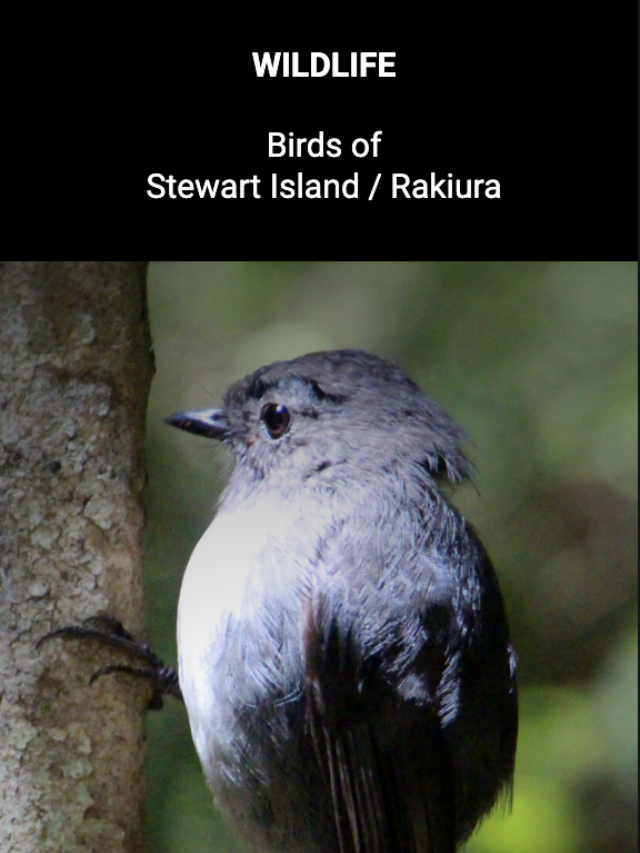
Birds of Stewart Island / Rakiura
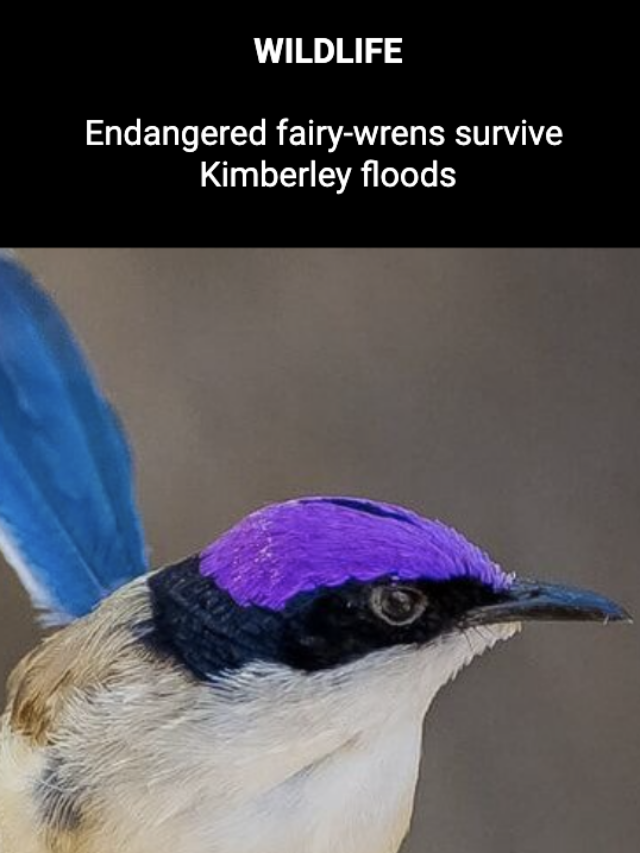
Endangered fairy-wrens survive Kimberley floods
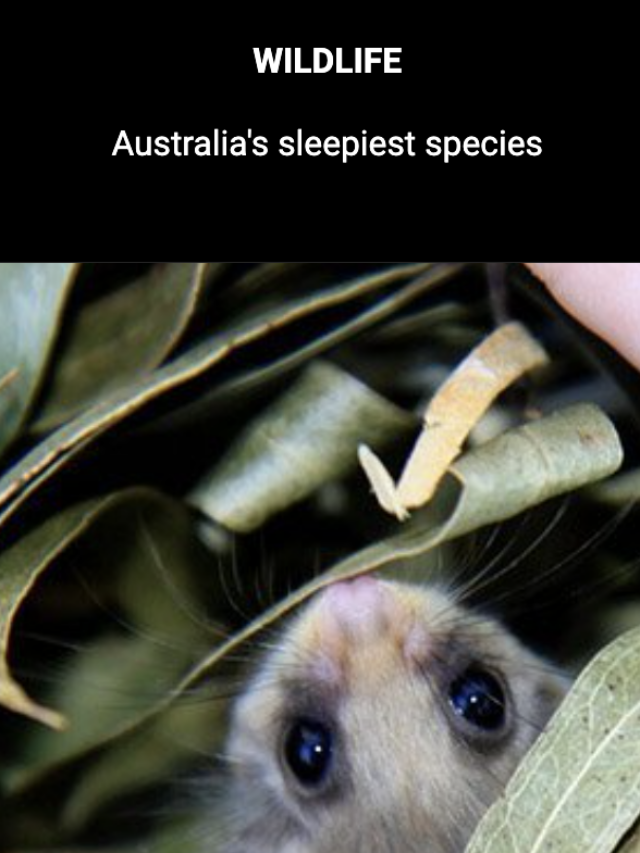
Australia’s sleepiest species
White Island Tours

- See all photos

Similar Experiences

Most Recent: Reviews ordered by most recent publish date in descending order.
Detailed Reviews: Reviews ordered by recency and descriptiveness of user-identified themes such as waiting time, length of visit, general tips, and location information.
WHITE ISLAND TOURS (Whakatāne) - All You Need to Know BEFORE You Go
Navigation for News Categories
Whakaari/white island eruption: tour company cannot afford fines, likely to close.

Twenty-two people died when Whakaari/White Island erupted in December 2019. Photo: Supplied/ University of Canterbury
White Island Tours faces potential closure after being fined over half a million dollars for its role in the Whakaari/White Island disaster.
Twenty-two people died and 25 others were injured when the island - a popular tourist site - erupted in 2019 .
The company, which took visitors to the island via boat, was fined $517,000 and ordered to pay $5 million in reparations to the victims .
Richard Raymond, the counsel for White Island Tours, said the reparations would be paid by insurance.
"Fortunately, WIT had the foresight to take out the appropriate insurance, statutory liability insurance it's called, and that policy enables reparation to be paid to victims of health and safety breaches.
"That will be paid promptly, certainly within the next 21 days or so, to the Ministry of Justice, who are tasked with administering the collection and the payment out of reparation to the victims."
However, Raymond said the company was not in a position to pay the fines.
"That is a more difficult issue. The company doesn't have any funds to pay a fine, given that the company has not been trading for over three years, has no assets and has considerable debts."

Richard Raymond is the counsel for White Island Tours. Photo: RNZ / Marika Khabazi
He said White Island Tours was likely to close its doors.
"The timeframe for the discussions on liquidations will take place over the next week to two weeks, and the decision will be made by the only remaining director of the company as to whether to place the company into liquidation or whether there are advantages for keeping it going a little longer.
"But it's likely that the company will go into liquidation."
Raymond said a coroner's inquiry into the tragedy was set to begin next year.
The coroner would be looking at aspects of the disaster like the search and rescue operation, whether there were sufficient treatment facilities available, and WorkSafe's role in approving safety audits to allow tours to take place .
An independent review has already found that WorkSafe fell short of good practice in its regulation of activities on Whakaari/White Island.
"[A coronial inquiry] is not a prosecution... but a learning exercise to improve the systems that we work under in New Zealand," Raymond said.
The inquiry could bring more accountability for the tragedy, he said.
Copyright © 2024 , Radio New Zealand
Related Stories
Sentencing 'bittersweet' for brother of killed guide - 'it doesn't bring anybody home'.
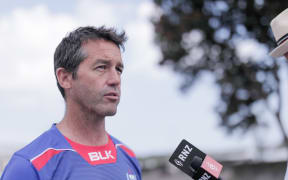
Whakaari eruption victims and their families will receive $10m in reparations, but pointing blame doesn't make it any easier, Mark Inman says. Audio
Whakaari eruption victims awarded $10m in reparations
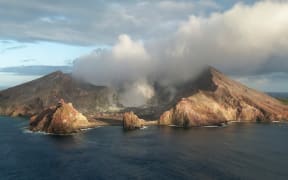
Judge allocates each individual $250,000, but says some victims may get more.
Whakaari tour companies maintain they were misled by WorkSafe, other govt agencies

Several companies being sentenced for health and safety failings in the lead up to the Whakaari White Island eruption argue that their culpability needs to be considered in the context of WorkSafe's…
Whakaari trial: 'You cannot mend a mother's broken heart'

Victims of the Whakaari / White Island disaster returned to the Auckland District Court to confront the five tourism companies found guilty in last year's trial.
'Sheer recklessness' - Whakaari victims' families speak in court

The family of a couple killed in the Whakaari White Island eruption have told a sentencing judge they want the companies involved held to account.
New Zealand
- Massey University forced to cancel online exams due to technical problems
- Invercargill mayor Nobby Clark faces another code of conduct complaint
- 'I'm sick of it' - Rising sports star Mea Motu calls time on domestic violence
- Government asks for inquiry into banking competition
- Migrant arrivals up 25%, departures up nearly a third in last year Stats NZ figures show
- Hastings has its hottest June day on record
Get the RNZ app
for ad-free news and current affairs

Top News stories
New Zealand RSS
Follow RNZ News

Whakaari/White Island court case will change the level of accepted risk in NZ’s tourism industry
Adjunct Senior Lecturer in Tourism Management/ Adjunct Associate Professor, University of South Australia
Professor of Tourism, Griffith University
Disclosure statement
The authors do not work for, consult, own shares in or receive funding from any company or organisation that would benefit from this article, and have disclosed no relevant affiliations beyond their academic appointment.
Griffith University and University of South Australia provide funding as members of The Conversation AU.
View all partners
An Auckland court has found Whakaari Management Limited (WML) guilty of breaching workplace safety laws relating to the Whakaari/White Island eruption in 2019. This decision could have implications for anyone involved in adventure tourism in New Zealand.
When Whakaari erupted on December 9 2019 there were 47 people on the island. The eruption killed 22 of them and injured 25, some severely. The island was at alert level VAL 2 (moderate to heightened volcanic unrest) when it erupted.
As owner of the island, WML was charged with failing to adequately minimise the risks to tourists.
The court’s guilty verdict will likely result in significant changes to the NZ$26.5 billion tourism industry. So how did we get here and what is likely to change?
New Zealand’s most active volcano
The Buttle family has owned Whakaari since 1936. Brothers Peter, James and Andrew Buttle inherited the island in 2012 and own it through a family trust. The trust leased Whakaari to WML (with the Buttles as the company’s directors).
WML had licensing agreements with tour companies to run commercial walking tours.
Read more: Why were tourists allowed on White Island?
Of the 47 people on the island when it erupted, 38 were part of a tour organised through the Royal Caribbean cruise ship Ovation of the Seas. Questions quickly arose about how aware tourists were of the risks and who might be held responsible.
WorkSafe New Zealand originally charged 13 parties under the Health and Safety at Work Act . Six eventually pleaded guilty to the charges and six, including the three Buttle brothers , had their cases dismissed.
The case against WML
WML was charged with breaching two sections of the act. The company was found guilty of one charge while the other was dismissed.
A key question in the court case was what responsibility WML bore when it licensed others to run the tour operations on the island.
WML argued it was only a landowner and not responsible for tourists’ safety. The company also claimed it had no physical presence on Whakaari or involvement in day-to-day tourism operations.
However, Judge Evangelos Thomas did not accept WML’s “passive owner” argument. The judge pointed to several factors as evidence, including:
- its business was to generate income through the enabling of commercial walking tours on Whakaari
- it entered into the licence agreements and had termination rights for breaches
- it maintained a direct and continuing relationship with tour operators
- it engaged with tour operators and other relevant entities, including Geological and Nuclear Sciences (GNS), civil defence and various agencies interested and involved in increasing tourist numbers to Whakaari
- it had occasional direct engagement with WorkSafe and GNS.
The judge also noted an earlier eruption in 2016 should have had all Whakaari stakeholders on notice for sound risk assessment. This eruption occurred when Whakaari was at VAL 1 (minor volcanic unrest). Fortunately it occurred at night when there were no visitors on the island.
Judge Thomas argued this showed the volcano
could erupt at any time and without warning, with the risk of death or serious injury to tourists or tour guides who may be there at that time.
WML should have engaged experts in volcanology and health and safety to advise on risks presented by tours to Whakaari, the judge found.
Sentencing will happen in February with a maximum possible penalty of a $NZ1.5 million fine.

Adventure tourism rules have already changed
This tragedy has already impacted the adventure tourism sector of New Zealand.
In August, the workplace relations and safety minister announced government changes to the rules for adventure tourism operations. Minister Carmel Sepuloni said:
Adventure activity operators will now be required by law to communicate serious risks to customers, meaning prospective participants can be fully informed of risks before buying a ticket, in the time before the activity begins and throughout the activity, including if the risks change.
WorkSafe was also given expanded powers to suspend, cancel or refuse registrations for adventure operators who cannot provide activities safely.
Read more: Whakaari tragedy: court case highlights just how complex it is to forecast a volcanic eruption
It is clear more rigorous risk assessments are required in New Zealand’s tourism industry. Responsibility for safety will no longer fall on tour operators alone.
All facets of the tourism supply chain, from land owners to tour operators to transport providers, will need to fulfil certain responsibilities to ensure the safety of their customers and workers. This will include careful consideration of the definition of “serious risk” and the many possible sources of risk.
Agencies such as the Meteorological Service and GNS will need to update adventure tour operators on a day-to-day basis. Natural hazards and risks such as extreme weather events, as well as volcanic and seismic risks, will need to be understood, factored into the planning of tour operations, and clearly communicated.
Reducing the risk in adventure tourism
Risk is an exciting attraction of adventure experiences for tourists in New Zealand. But public perception of risk is not the same as actual risk.
Some adventure tourism businesses offer experiences, such as bungy jumping, based on high perceived risk. But in reality these are low risk due to long-standing safety protocols.
Others, such as tours to geologically active locations, offer low perceived risk but there is the potential for periodic and unpredictable high actual risk.
Operators providing such experiences will now be obligated to shoulder greater responsibilities in ensuring such risks do not cause real harm.
All aspects of risk associated with the full spectrum of tourism businesses and tour operations, including but not limited to adventure tourism activities, will now need to be considered more carefully in Aotearoa New Zealand.
- New Zealand
- Health and safety
- Adventure tourism
- Whakaari/White Island

Business Advisor

Laboratory Head - RNA Biology

Head of School, School of Arts & Social Sciences, Monash University Malaysia

Chief Operating Officer (COO)

Data Manager

IMAGES
COMMENTS
Book tours and tickets to experience White Island (Whakaari). Reserve a ticket for your trip to North Island today. Free cancellation and payment options - Viator.
Information on this tour can be found via the separate TripAdvisor page: Moutohora Island Sanctuary (Whale Island) - Day Tour. In a country bursting with natural wonders, Whakaari/White Island is a standout. Located 49km off the coast of Whakatane, in the pristine waters of the Bay of Plenty, it is one of the world's most accessible volcanoes.
Whakaari/White Island is an active marine volcano that has attracted visitors from around the world for decades. To Māori and local Iwi (tribe) Ngāti Awa, Whakaari is a treasured ancestor and features in many stories and legends of the region. ... As a result of the eruption event, there are currently no on-land tours of the island in ...
White Island (Whakaari) - tours and tickets. Book tickets to experience White Island (Whakaari) in North Island today. Check out Viator's selection with millions of trusted reviews.
Whakaari/White Island. Whakaari / White Island is one of New Zealand's most active volcanos, situated 48km off the coast of Whakatane in the North Island. In December of 2019 a volcanic eruption occurred at Whakaari / White Island. To ensure the safety of locals and visitors there are currently no boat tours to, or helicopter flights that ...
Whakaari/White Island Visitor Information. White Island, also known in Maori as Whakaari, is an active volcano situated 49 km off the coast of New Zealand's Bay of Plenty region. White Island is easily accessible as tour operators run regular trips to the island from Whakatane, in fact it is one of the most accessible active marine volcanos in ...
Go on a virtual tour of White Island (Whakaari) using Google Street View. White Island is an active volcano situated in the ocean 48km from the township of Whakatane, Bay Of Plenty, New Zealand. White island attracts visitors from all over the world including a variety of sea life.
Whakaari White Island tours may include a relaxing cruise, a food or wine tour, escorted tours, package tours, adventure tours, motorcycle tours, train tours and PGA golf tours. more. If you have a love for the outdoors, New Zealand is the ideal destination for you. Take a 4WD tour, explore the off-beaten track with a tour guide, hire a ...
White Island Tours, Whakatāne: See 1,102 reviews, articles, and 969 photos of White Island Tours, one of 51 Whakatāne attractions listed on Tripadvisor.
Whakaari/White Island Boat and Sailing Tours. White Island, also known in Maori as Whakaari, is an active volcano situated 49 km off the coast of New Zealand's Bay of Plenty region. White Island is easily accessible as tour operators run regular trips to the island from Whakatane, in fact it is one of the most accessible active marine volcanos ...
How to Get to White Island. White Island (Whakaari) is located within northern New Zealand's Bay of Plenty, 29 miles (48 km) offshore. Guided tours are the only way you can get there. Tours run from both Whakatane, the closest town to White Island, and Tauranga, 56 miles (91 km) away. Some tours also run from further afield, such as Taupo or ...
White Island Flights offers you the unique opportunity to view the beauty of Aotearoa from a vantage point few get to experience. With our experienced pilot and top-tier aircraft, you can enjoy a comfortable, safe, and visually stunning ride. Experience White Island. The Volcanic Ultimate Tour.
The purchase of the White Island Tours, a cafe and motel in 2017 did just that - creating more than 50 jobs and generating $4.5m revenue. But Ngāti Awa did not imagine what would unfold on the island on 9 December last year, when the volcano on Whakaari / White Island exploded and claimed lives.
Whakaari/White Island is an active volcano made famous in a new Netflix documentary. Here's what to know about trying to visit the active volcano.
This eruption took place on Whakaari/White Island, New Zealand, on 27 April 2016, more than three years before the catastrophe in December last year that claimed the lives of 21 people (17 of them Australians) and injured 26 others. Geologists from GNS Science, NZ's leading provider of geoscientific research, reconstructed the pulses of the ...
White Island (Whakaari) - tours and tickets. Book tickets to experience White Island (Whakaari) in North Island today. Check out Viator's selection with millions of trusted reviews.
On 9 December 2019, Whakaari / White Island, an active stratovolcano island in New Zealand's northeastern Bay of Plenty region, explosively erupted. [3] The island was a popular tourist destination, known for its volcanic activity, and 47 people were on the island at the time. Twenty-two people died, either in the explosion or from injuries ...
Some of the tourists who bought their tour ticket to Whakaari through Royal Caribbean Cruises have already reached settlements after suing the Florida-based company in the US.
White Island Tours had exclusive rights to run tours with a boat to the island - before the eruption 17,000 people visited Whakaari on its tours each year. The summary of facts said the company did not have an accurate understanding of the risk posed to its tourists and tour guides by volcanic activity on Whakaari.
All tours to Whakaari / White Island have been cancelled. Moutohora / Whale Island tours have resumed. Information on this tour can be found via the separate TripAdvisor page: Moutohora Island Sanctuary (Whale Island) - Day Tour.
Survivors of one of New Zealand's worst natural disasters have described the searing pain of being lashed by burning sand, ash and rocks during a volcanic eruption on Whakaari or White Island in ...
White Island Tours faces potential closure after being fined over half a million dollars for its role in the Whakaari/White Island disaster. Twenty-two people died and 25 others were injured when the island - a popular tourist site - erupted in 2019. The company, which took visitors to the island via boat, was fined $517,000 and ordered to pay $5 million in reparations to the victims.
Everyone involved in the tourism industry will need to manage risk differently after a court found the landowners of Whakaari/White Island guilty of breaching the Health and Safety at Work Act.